Application of Energy-Resolving Neutron Imaging to Major-Component Analyses of Materials Using Four-Channel Superconducting Detector
IF 1
4区 工程技术
Q4 ENGINEERING, ELECTRICAL & ELECTRONIC
The Dang Vu, Hiroaki Shishido, Kazuya Aizawa, Takayuki Oku, Kenichi Oikawa, Masahide Harada, Kenji M. Kojima, Shigeyuki Miyajima, Kazuhiko Soyama, Tomio Koyama, Mutsuo Hidaka, Soh Y. Suzuki, Manobu M. Tanaka, Masahiko Machida, Shuichi Kawamata, Takekazu Ishida
求助PDF
{"title":"Application of Energy-Resolving Neutron Imaging to Major-Component Analyses of Materials Using Four-Channel Superconducting Detector","authors":"The Dang Vu, Hiroaki Shishido, Kazuya Aizawa, Takayuki Oku, Kenichi Oikawa, Masahide Harada, Kenji M. Kojima, Shigeyuki Miyajima, Kazuhiko Soyama, Tomio Koyama, Mutsuo Hidaka, Soh Y. Suzuki, Manobu M. Tanaka, Masahiko Machida, Shuichi Kawamata, Takekazu Ishida","doi":"10.1002/tee.24144","DOIUrl":null,"url":null,"abstract":"<p>We proposed a current-biased kinetic inductance detector (CB-KID) as a novel superconducting detector to construct a neutron transmission imager. The characteristics of a superconducting neutron detector have been systematically studied to improve a spatial resolution down to 10<span></span><math>\n <semantics>\n <mrow>\n <mi>μm</mi>\n </mrow>\n <annotation>$$ \\upmu \\mathrm{m} $$</annotation>\n </semantics></math> in transmission imaging. In this study, we report the application of the energy-resolving neutron imaging to investigate major components of materials by analyzing neutron transmission spectra from 1 meV to 500 keV. We succeeded in identifying that copper (Cu) and iron (Fe) are major components respectively in commercial nuts and screws as test samples with the aid of Rietveld imaging of transmission spectra (RITS) program in analyzing transmission spectra in longer wavelengths. The Ti screw was also confirmed by comparing the nuclear resonance absorption measurements and simulations in high-energy regions. We demonstrated that our superconducting neutron detector is applicable to reveal the transmission spectra in the wide range from cold-neutron energies <span></span><math>\n <semantics>\n <mrow>\n <mo>∼</mo>\n <mi>meV</mi>\n </mrow>\n <annotation>$$ \\sim \\mathrm{meV} $$</annotation>\n </semantics></math> to higher neutron energies even up to 500 keV. By selecting distinctive energy regions of pulsed neutrons, we succeeded in mapping the distribution of SmSn<sub>3</sub> compound using the strong neutron absorption in samarium (Sm) and the selective nuclear-resonance dips in Sm. By taking advantage of using CB-KID in conducting neutron imaging, the CB-KID method is extensively useful for various purposes in material sciences through energy-selective neutron spectroscopy from 1 meV to 500 keV. © 2024 Institute of Electrical Engineers of Japan and Wiley Periodicals LLC.</p>","PeriodicalId":13435,"journal":{"name":"IEEJ Transactions on Electrical and Electronic Engineering","volume":"19 11","pages":"1888-1894"},"PeriodicalIF":1.0000,"publicationDate":"2024-06-20","publicationTypes":"Journal Article","fieldsOfStudy":null,"isOpenAccess":false,"openAccessPdf":"","citationCount":"0","resultStr":null,"platform":"Semanticscholar","paperid":null,"PeriodicalName":"IEEJ Transactions on Electrical and Electronic Engineering","FirstCategoryId":"5","ListUrlMain":"https://onlinelibrary.wiley.com/doi/10.1002/tee.24144","RegionNum":4,"RegionCategory":"工程技术","ArticlePicture":[],"TitleCN":null,"AbstractTextCN":null,"PMCID":null,"EPubDate":"","PubModel":"","JCR":"Q4","JCRName":"ENGINEERING, ELECTRICAL & ELECTRONIC","Score":null,"Total":0}
引用次数: 0
引用
批量引用
Abstract
We proposed a current-biased kinetic inductance detector (CB-KID) as a novel superconducting detector to construct a neutron transmission imager. The characteristics of a superconducting neutron detector have been systematically studied to improve a spatial resolution down to 10
μm
$$ \upmu \mathrm{m} $$
in transmission imaging. In this study, we report the application of the energy-resolving neutron imaging to investigate major components of materials by analyzing neutron transmission spectra from 1 meV to 500 keV. We succeeded in identifying that copper (Cu) and iron (Fe) are major components respectively in commercial nuts and screws as test samples with the aid of Rietveld imaging of transmission spectra (RITS) program in analyzing transmission spectra in longer wavelengths. The Ti screw was also confirmed by comparing the nuclear resonance absorption measurements and simulations in high-energy regions. We demonstrated that our superconducting neutron detector is applicable to reveal the transmission spectra in the wide range from cold-neutron energies
∼
meV
$$ \sim \mathrm{meV} $$
to higher neutron energies even up to 500 keV. By selecting distinctive energy regions of pulsed neutrons, we succeeded in mapping the distribution of SmSn3 compound using the strong neutron absorption in samarium (Sm) and the selective nuclear-resonance dips in Sm. By taking advantage of using CB-KID in conducting neutron imaging, the CB-KID method is extensively useful for various purposes in material sciences through energy-selective neutron spectroscopy from 1 meV to 500 keV. © 2024 Institute of Electrical Engineers of Japan and Wiley Periodicals LLC.
利用四通道超导探测器将能量解析中子成像技术应用于材料主要成分分析
我们提出了一种电流偏置动感探测器(CB-KID),作为一种新型超导探测器来构建中子透射成像仪。我们对超导中子探测器的特性进行了系统研究,以提高透射成像中低至 10 的空间分辨率。在本研究中,我们报告了应用能量分辨中子成像技术,通过分析 1 meV 至 500 keV 的中子透射光谱来研究材料的主要成分。借助里特维尔德透射光谱成像(RITS)程序分析较长波长的透射光谱,我们成功地确定了作为测试样品的商用螺母和螺钉的主要成分分别是铜(Cu)和铁(Fe)。我们还通过比较高能区的核共振吸收测量结果和模拟结果,确认了钛螺钉。我们证明了我们的超导中子探测器适用于揭示从冷中子能量到更高中子能量(甚至高达 500 keV)范围内的透射光谱。通过选择脉冲中子的独特能量区域,我们利用钐(Sm)的强中子吸收和Sm的选择性核共振点,成功地绘制出了SmSn3化合物的分布图。利用 CB-KID 进行中子成像的优势,CB-KID 方法通过 1 meV 至 500 keV 的能量选择性中子能谱分析,可广泛用于材料科学的各种用途。© 2024 日本电气工程师学会和 Wiley Periodicals LLC。
本文章由计算机程序翻译,如有差异,请以英文原文为准。

 求助内容:
求助内容: 应助结果提醒方式:
应助结果提醒方式:


